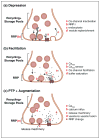Short-term forms of presynaptic plasticity
- PMID: 21353526
- PMCID: PMC3599780
- DOI: 10.1016/j.conb.2011.02.003
Short-term forms of presynaptic plasticity
Abstract
Synapses exhibit several forms of short-term plasticity that play a multitude of computational roles. Short-term depression suppresses neurotransmitter release for hundreds of milliseconds to tens of seconds; facilitation and post-tetanic potentiation lead to synaptic enhancement lasting hundreds of milliseconds to minutes. Recent advances have provided insight into the mechanisms underlying these forms of plasticity. Vesicle depletion, as well as inactivation of both release sites and calcium channels, contribute to synaptic depression. Mechanisms of short-term enhancement include calcium channel facilitation, local depletion of calcium buffers, increases in the probability of release downstream of calcium influx, altered vesicle pool properties, and increases in quantal size. Moreover, there is a growing appreciation of the heterogeneity of vesicles and release sites and how they can contribute to use-dependent plasticity.
Copyright © 2011. Published by Elsevier Ltd.
Figures


References
-
- Zucker RS, Regehr WG. Short-term synaptic plasticity. Annu Rev Physiol. 2002;64:355–405. - PubMed
-
- Rizzoli SO, Betz WJ. Synaptic vesicle pools. Nat Rev Neurosci. 2005;6:57–69. - PubMed
-
- Schneggenburger R, Sakaba T, Neher E. Vesicle pools and short-term synaptic depression: lessons from a large synapse. Trends Neurosci. 2002;25:206–212. - PubMed
Publication types
MeSH terms
Substances
Grants and funding
LinkOut - more resources
Full Text Sources

